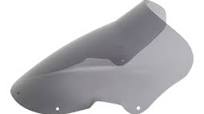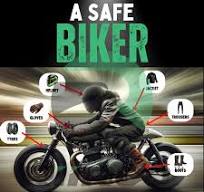Enhancing Your Ride: The Importance of Motorcycle Windshields

The Importance of Motorcycle Windshields
Motorcycle windshields, also known as windscreens, play a crucial role in enhancing the riding experience and ensuring rider comfort and safety. These protective shields are designed to shield riders from wind, debris, insects, and other elements encountered while riding.
One of the primary benefits of motorcycle windshields is their ability to reduce wind resistance and turbulence. By deflecting the airflow away from the rider, windshields help create a smoother and more comfortable ride, especially at higher speeds. This not only reduces rider fatigue but also improves overall aerodynamics.
In addition to improving aerodynamics, motorcycle windshields provide protection from flying debris such as rocks, bugs, dust, and other road hazards. This added layer of protection helps keep riders safe and minimizes the risk of injury or accidents caused by unexpected objects hitting the rider.
Moreover, motorcycle windshields can also enhance visibility by reducing glare from the sun or headlights of oncoming vehicles. This improved visibility allows riders to focus better on the road ahead and react quickly to changing road conditions or obstacles.
When choosing a motorcycle windshield, riders should consider factors such as size, shape, material, and tint. The right windshield should be properly sized to provide adequate coverage without obstructing vision. Additionally, opt for durable materials like polycarbonate or acrylic that can withstand impact and weather conditions.
Overall, motorcycle windshields are essential accessories that not only improve rider comfort but also enhance safety on the road. By investing in a quality windshield that suits your riding style and preferences, you can enjoy a smoother ride with added protection against external elements.
8 Essential Tips for Maintaining and Optimising Your Motorcycle Windshield
- Ensure the windshield is properly installed and secure.
- Choose a windshield that suits your riding style and preferences.
- Regularly clean the windshield to maintain visibility.
- Inspect for any cracks or damage that may affect its effectiveness.
- Adjust the height of the windshield to reduce wind buffeting.
- Consider adding a protective coating to prevent scratches and improve durability.
- Replace the windshield if it becomes worn out or obstructs your view.
- Check local regulations to ensure your windshield complies with legal requirements.
Ensure the windshield is properly installed and secure.
It is crucial to ensure that your motorcycle windshield is properly installed and securely fastened. A securely installed windshield not only enhances the overall aesthetics of your bike but also plays a vital role in providing effective protection against wind, debris, and other elements while riding. Proper installation helps prevent the windshield from vibrating or coming loose during rides, ensuring a safe and comfortable riding experience. Regularly inspecting the mounting hardware and making any necessary adjustments will help maintain the integrity of your windshield and keep you safe on the road.
Choose a windshield that suits your riding style and preferences.
When selecting a motorcycle windshield, it is crucial to choose one that aligns with your riding style and personal preferences. The right windshield should not only provide adequate protection from wind and debris but also complement your overall riding experience. Whether you prefer a sleek, low-profile design for a sporty look or a larger, more protective shield for long-distance touring, selecting a windshield that suits your individual needs ensures optimal comfort and enjoyment on the road. By considering factors such as size, shape, material, and tint, riders can customise their windshield to enhance both their safety and riding pleasure.
Regularly clean the windshield to maintain visibility.
Regularly cleaning your motorcycle windshield is essential to maintain optimal visibility while riding. Dust, dirt, bugs, and other debris can accumulate on the windshield over time, obstructing your view of the road ahead. By keeping your windshield clean, you can ensure clear visibility, reduce glare from the sun or headlights, and enhance overall safety during your rides. Make it a habit to clean your motorcycle windshield regularly using appropriate cleaning products to enjoy a clear and unobstructed view every time you hit the road.
Inspect for any cracks or damage that may affect its effectiveness.
It is essential for motorcycle riders to regularly inspect their windshields for any cracks or damage that could compromise their effectiveness. Even minor cracks or chips can weaken the structural integrity of the windshield and reduce its ability to provide adequate protection from wind, debris, and other elements encountered while riding. By conducting routine inspections and addressing any issues promptly, riders can ensure that their motorcycle windshields remain in optimal condition to enhance both safety and comfort on the road.
Adjust the height of the windshield to reduce wind buffeting.
Adjusting the height of your motorcycle windshield can significantly reduce wind buffeting and enhance your riding experience. By finding the optimal height that directs airflow over your head and body, you can minimize turbulence and noise while maintaining a comfortable riding position. Experimenting with different windshield heights allows you to tailor your setup to suit your specific preferences and riding conditions, ensuring a smoother and more enjoyable journey on the road.
Consider adding a protective coating to prevent scratches and improve durability.
When it comes to maintaining the longevity and appearance of your motorcycle windshield, a valuable tip to consider is adding a protective coating. By applying a protective coating, you can effectively prevent scratches and enhance the durability of your windshield. This additional layer of protection not only helps maintain the clarity and integrity of the windshield but also ensures that it remains in optimal condition for longer periods, ultimately extending its lifespan and preserving its functionality.
Replace the windshield if it becomes worn out or obstructs your view.
It is crucial for motorcyclists to replace their windshield if it shows signs of wear or begins to obstruct their view. A worn-out or damaged windshield can compromise rider safety by reducing visibility and increasing the risk of accidents. By promptly replacing a deteriorating windshield with a new one that provides a clear and unobstructed view, riders can ensure optimal visibility on the road and maintain a safe riding experience. Regularly inspecting and replacing motorcycle windshields when needed is an essential part of responsible motorcycle maintenance.
Check local regulations to ensure your windshield complies with legal requirements.
It is essential for motorcycle riders to check local regulations to ensure that their windshield complies with legal requirements. Different regions may have specific rules regarding the size, shape, and visibility of motorcycle windshields. By verifying that your windshield meets these legal standards, you can avoid potential fines or penalties while ensuring your safety and adherence to road laws. Always stay informed about local regulations to ride responsibly and lawfully with a compliant windshield.

